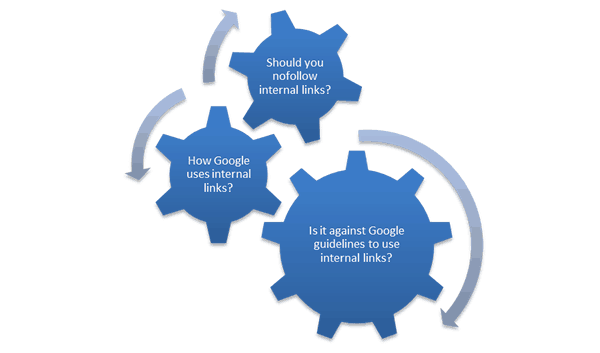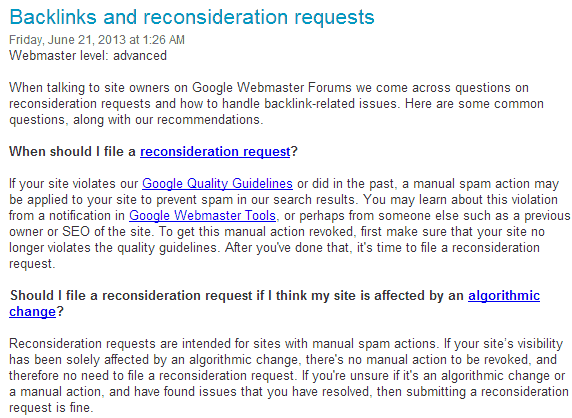
Internal linking is very important not only for SEO but for an enhanced user experience. Best practices for internal linking dictate that any links pointing to pages within the website should provide value to users and also assist search engines discover more pages from that website.
What is internal linking?
A webpage can have 2 types of links. The first type is what we call external links and these are links pointing to pages outside the boundaries of the web site. For example if you click this link, you will go to my facebook page.
The second type;
Links pointing to other web pages but on the same domain – for example if you click this link you will go to another of our Webmaster guideline page .
External links
First things first: A quick take on best practices for external links
As SEO’s we ‘grew up’ with the moto ‘a link is a link’ and this makes a lot of people believe that external links and internal links should be treated the same way but this is another SEO misconception.
The role of external links is different from that of internal links and if you don’t use external links wisely, you may get into trouble. I talk more about external links in the off-page SEO article but some best practices for the usage of external links are:
- Link out when it is absolutely necessary
- Try not to have more than a couple of external links per page
- Link only when it provides value to the reader
- Link only to websites you trust
- Link only to websites that have unique and original content
- Link to related websites only
- If you want to minimize the risk of getting a link penalty, use the ‘nofollow’ tag for external links (at least for some, not necessarily for all)
Internal links
What does Google and Bing say about internal link building and do you risk getting a penalty if you are using keyword anchor text for your internal links?
Provided that you follow the best practices for internal linking (as we will see below), you don’t run any risk for using internal links in your webpages. Matt Cutts (head of the Google Quality team) in a recent video confirmed that internal links are treated differently from external links and provided that you are not doing any exaggerations (for example having more than 100 links per page), you don’t have to worry that you are violating Google webmaster guidelines.
Besides Matt’s reply on Youtube, the best way to understand how to use internal links is to review how Google and other big trusted websites are using internal links.

What about Wikipedia?
I think the perfect example for internal link usage is Wikipedia. If you view any page on Wikipedia you will immediately notice that they are using tens of internal links (with keywords as the anchor text).

How Google is using internal links?
Recently Google published a new blog post in the Google webmaster central blog and I think it’s a very good example to use in order to understand how Google is using internal links. It is good to know because what they are doing in their blogs is not against their own guidelines so someone can say that it’s safe to use as well.
As you can see from the screenshot below (which is only half the post), they are using a lot of internal links and they are heavily using keywords for the anchor text as well. The page has 19 internal links within text alone + the links in the menu + the links in the comments.

What does Bing say about internal linking?
Google is not the only search engine out there so for optimum results it’s always good to know how other search engines approach on-page SEO and internal link building.
Bing also supports the use of internal links in their webmaster guidelines. In particular they include a reference to internal links under the SEO section stating that internal links are useful for creating a view of how your website pages are related and also help users find related content.
Should you “nofollow” internal links?
A link, whether this is an external or internal link, is a signal that you trust that page and it is said that it passes PageRank from your page to the linking page.
It was recognized over the years that sometimes you need to link to a particular page but:
- You are not sure if it’s trusted or not
- The links are beyond your control (i.e. links in comments etc)
- You want to place a text link ad on your website without this to be considered as selling links
To cover this cap, some search engines (Google is one of them) introduced the “nofollow” attribute. When you add the ‘nofollow’ in a link basically what you are telling search engines is not to take into account the particular link as a ‘vote of trust’ to the linking website. You can read more about the usage of the nofollow and some best practices here but this is more applicable for external links.
You should nofollow an internal link when:
- It points to a page that is not accessible by search engines (for example pages behind a login page)
- The link goes to a page that is not important (for example if you have a page for bibliography or something similar and you reference this page from your posts, you can nofollow the link since it is not something you want to be made available in the search results)
- Tag pages – I usually nofollow all my tag pages since I need to give more value to the actual pages and don’t want to rank my tag pages (it’s too difficult anyway to rank a tag page than a normal page).
Best practices for internal linking
Although I have described most of the best practices above, for list lovers here is a summary:
- Add internal links when it is useful for the user experience
- You can add keywords in the anchor text without any problems but it is always best practice to avoid exaggerations. In other words although it is not forbidden that does not mean that you should not use non-keyword anchor text for internal links as well. Variation in both internal and external links is always recommended.
- Try not to use more than 6-7 internal links per page (within the body text). This is not a rule or a guideline but it’s just my own recommendation.
- Use the nofollow tag wisely (see section above)
- Make sure that you don’t have any broken internal links as this is bad for SEO.
- Link related pages together not pages that have no related content for the sake of internal linking
- If you cannot use keywords within a sentence for the internal links you can always add them as additional reading. For example, to find out more about SEO you can read my 5 Simple SEO tips for better rankings article.
- As a general SEO guideline, make sure that the pages you want to rank higher in search engines have the greater number of internal links.
- You can use the ‘Internal links’ report under the section ‘Traffic’ in Google webmaster tools to find out the status of your internal link building (which pages have the most links, anchor text used and many more info).
- Make sure that the total number of links per page (internal and external) is no more than a 100
Conclusion
Internal linking is important for SEO but still this is one area that many webmasters get wrong. They either don’t use any internal links or they treat them the same way as external links which is a wrong approach.
If you follow the best practices outlined above, internal links can only benefit a website and make the user experience better and more enjoyable. Happy users will stay on the page for longer and they will also visit more pages within the same site before they leave.
Consider internal links as a way to build your own web and don’t forget that you can always go back and update an existing page of your site to add a couple of internal links if this will help the users find more related content from your website.




No comments:
Post a Comment